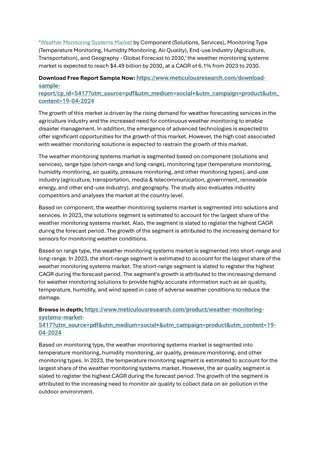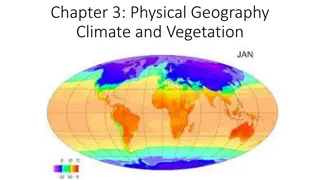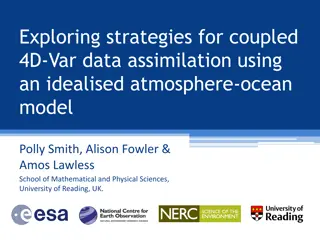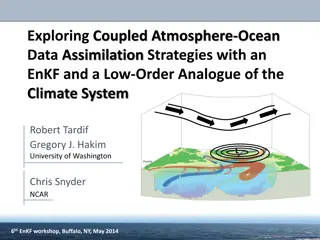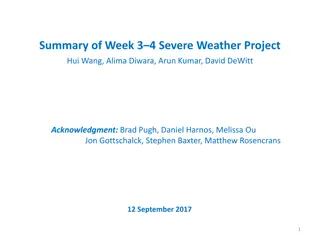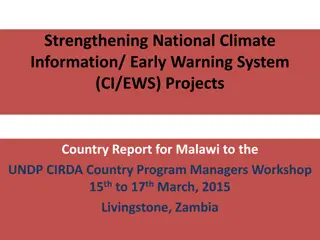Facilitating Coupled Model Development for Climate and Weather via CIME
Mariana Vertenstein discusses the challenges in coupled earth system modeling and how CIME (Common Infrastructure for Modeling the Earth) addresses them. CIME comprises a flexible coupling infrastructure, user-friendly testing utilities, and prioritizes collaborative development to meet forecast needs.
Download Presentation

Please find below an Image/Link to download the presentation.
The content on the website is provided AS IS for your information and personal use only. It may not be sold, licensed, or shared on other websites without obtaining consent from the author.If you encounter any issues during the download, it is possible that the publisher has removed the file from their server.
You are allowed to download the files provided on this website for personal or commercial use, subject to the condition that they are used lawfully. All files are the property of their respective owners.
The content on the website is provided AS IS for your information and personal use only. It may not be sold, licensed, or shared on other websites without obtaining consent from the author.
E N D
Presentation Transcript
Facilitating coupled model development for both climate and weather via CIME (Common Infrastructure for Modeling the Earth) Mariana Vertenstein (CGD)
Outline 1. What is a big challenge for coupled earth system modeling? 2. What is CIME and what is it comprised of? 3. How does CIME address challenges of coupled earth system modeling? Flexible coupling infrastructure User-friendly case-control system User-friendly regression testing, unit testing, porting and verification utilities 4. What are next steps for CIME to address forecast needs? 5. How are different parts of CIME collaboratively developed and prioritized?
What is a coupled model and associated complexities? A set of fully independent component models representing different parts of the earth system each at different time scales, potentially different resolutions and different processor layouts In order to provide dynamic feedbacks, the component models periodically exchange state and flux information via a coupling framework Managing a coupled model requires managing complexity of configuring, building and running a variety of component models, resolutions and processor layouts CIME was developed to address these challenges!
Why do we need a coupling infrastructure? river land ice land Driver/ Mediator sea-ice wave atm ocean Components do not exchange data with each other but only via communication with a mediator Each component can run on its own grid, decomposition, data structures and processor layout Driver runs on all Pes and controls the temporal evolution of the system Mediator does remapping and merging from source -> destination comps Currently Coupling framework is MCT moving to NUOPC/ESMF
CIME is comprised of 3 categories case control system, utilities, workflow Case Control System Creating/Building/Running Experiments System Testing Unit Testing CIME Compliant Workflow Utilities in CIME repository Mapping weight generation and checking tools (ESMF_Regrid and runoff map maker) Cylc Workflow Coupling Infrastructure Post Processing/ Diagnostics Statistical Verification Tool (PyCECT) Externals Data Models PIO MCT Core CIME Functionality Timers
CIME Coupling Infrastructure
Controlling Component Feedbacks Active atmosphere CAM Active atmosphere CAM Coupling framework enables feedbacks to be easily turned off and on for any component KEY to adding to new science to a component Active ocean POP/MOM Data OCN Only Data OCN effects CAM prescribed SST CAM and POP/MOM effect each other during simulation
Inter-component Activation and Deactivation of Feedbacks Data ROF MOSART CISM CTSM Data LND Driver/ Mediator CICE WW3 Data WAV Data ICE CAM/MPAS Data ATM Data POP MOM6 SOM/DOM Coupling infrastructure has permits interoperability of active and data components Inter-component feedbacks are easily activated and deactivated using CIME case control system
stand-alone CAM Configuration CAM Driver/ Mediator Data Ocn Slab Ocn or Prescribed SST CICE CTSM Prescribed mode All components are on same grid but each can have its own decomposition that ensures optimal load balancing CTSM, CICE and DOCN can all run concurrently on disjoint PES, optimizing performance
CIME Case Control System Complexity in CESM continues to grow rapidly currently support hundreds of out-of-the box experimental configurations and tests. Creating a new experiment is very complex no single user can know the entire details of all components! CIME Case Control System is a python based object- oriented package Lets users easily create customized experiments (using only 4 commands) with desired target feedbacks, component resolutions and component configurations. Keeps complexity hidden from users not dependent on the users having expert knowledge of the entire system. Parallel diagnostic packages can be run from case directory Provenance: experiment can be saved into run database so that it can be duplicated at a later time Can easily be plugged into CYCL workflow
CIME Regression and Unit Testing Case Control System is accompanied by an extensible and robust regression testing framework that is utilized by all CESM components All prognostic components leverage the testing framework component specific tests are specified by component itself - not centralized Can run hundreds of tests with different resolutions, feedbacks, science complexity, with one command
Next Steps in CIME Development for Forecasting Needs
New Features planned for CIME Addition of new capabilities in the case control system to accommodate forecast capability and not just climate capability Migration of coupling framework to ESMF/NUOPC Will bring in run-time regridding and run-time sequencing of components ESMF/NUOPC is becoming the de-facto coupling standard this will lead to enhanced interoperability of the system Working jointly with NOAA to accomplish this Coupling infrastructure will be that used by EMC/UFS
Thank you Questions?
CIME Governance and Development
How is CIME developed? Open joint collaboration on public GitHub repository between DOE/NCAR software developers without any formal governance CIME is developed and tested stand-alone CIME stand-alone continuous integration (Travis CI) CIME stand-alone regression tests and unit tests (required for pull requests) Prognostic component regression tests use CIME testing framework as well
Why does this work (1) CIME infrastructure has been set up to permit this joint open collaboration Modular object-oriented python (and fortran) code reuse between efforts Shared code whenever possible Separation when necessary machines, compilers have are implemented in separate locations in CIME but use the same underlying code
Why does this work (2) GitHub is a transformative way to collaborate Issues are raised in GitHub and resolved collaboratively Pull requests (PRs) are reviewed by both groups and the implementations must satisfy both groups in order for the PR to be accepted In practice, GitHub this process easy and transparent Documentation has been created via sphinx/rst and has been jointly developed and updated
CIME Tool for Verification and Porting
CESM Ensemble Consistency Test (ECT) Changes to hardware or software environment or CESM code CESM Data Big question: If , is the new result correct? Alternative question: Is statistically distinguishable from ?
CESM Ensemble Consistency Test (ECT) Approach: Evaluate new data in the context of an accepted ensemble of CESM runs Create accepted ensemble Evaluate: PASS or FAIL Statistically quantify variability Create "new" runs CESM-software engineers CESM-user Highlights: enables letting go of bit-for-bit reproducibility objective, user-friendly 9 time-step test rapid feedback for model developers




